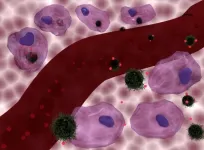(Press-News.org) Heating up cancer cells while targeting them with chemotherapy is a highly effective way of killing them, according to a new study led by UCL researchers.
The study, published in the Journal of Materials Chemistry B, found that "loading" a chemotherapy drug on to tiny magnetic particles that can heat up the cancer cells at the same time as delivering the drug to them was up to 34% more effective at destroying the cancer cells than the chemotherapy drug without added heat.
The magnetic iron oxide nanoparticles that carry the chemotherapy drug shed heat when exposed to an alternating magnetic field. This means that, once the nanoparticles have accumulated in the tumour area, an alternating magnetic field can be applied from outside the body, allowing heat and chemotherapy to be delivered simultaneously.
The effects of the two treatments were synergistic - that is, each treatment enhanced the effectiveness of the other, meaning they were more potent when combined than when separate. The study was carried out on cells in a lab and further research is needed ahead of clinical trials involving patients.
Senior author Professor Nguyen T. K. Thanh (Biophysics Group, UCL Physics & Astronomy) said: "Our study shows the enormous potential of combining chemotherapy with heat treatment delivered via magnetic nanoparticles.
"While this combination of therapy is already approved for the treatment of fast-growing glioblastomas, our results suggest it has potential to be used more widely as a broad anti-cancer therapy.
"This therapy also has potential to reduce the side effects of chemotherapy, by ensuring it is more highly targeted on cancer cells rather than healthy tissue. This needs to be explored in further pre-clinical tests."
In the study, researchers combined the magnetic nanoparticles with a commonly used chemotherapy drug, doxorubicin, and compared the effects of this composite in various scenarios on human breast cancer cells, glioblastoma (brain cancer) cells, and mouse prostate cancer cells.
In the most successful scenario, they found that heat and doxorubicin together killed 98% of brain cancer cells after 48 hours, when doxorubicin without heat killed 73%. Meanwhile, for the breast cancer cells, 89% were killed by heat and doxorubicin together, while 77% were killed after 48 hours by doxorubicin alone.
Cancer cells are more susceptible to heat than healthy cells - they undergo a slow death (apoptosis) once the temperature reaches 42 degrees Celsius, whereas healthy cells are able to withstand temperatures up to 45 degrees Celsius.
The researchers found that heating cancer cells by only a few degrees, to 40 degrees Celsius, enhanced the effectiveness of the chemotherapy, meaning the treatment could be effective with lower doses of nanoparticles.
They found the combination of therapies was most effective when the nanoparticles were absorbed, or internalized, by the cancer cells, but they found the chemotherapy was also enhanced when the nanoparticles shed heat while remaining outside the cancer cells (which would be an easier form of treatment to deliver). However, the effects at lower temperatures only occurred when the iron oxide nanoparticles were internalized or tightly deposited on to the surface of the cancer cells.
The nanoparticles also have a polymer coating that prevents the chemotherapy drug from leaching out into healthy tissue. The coating is heat and pH-sensitive, and is designed to release the drug when temperature rises and the nanoparticles are internalized within tiny pockets in cells called "lysosomes", which have a lower pH than the rest of the cell medium. This intracellular delivery of the drug was particularly effective for the mouse prostate cancer cells, which showed superior and synergetic cell death effect, especially when the temperature reached 42°C.
Co-author Dr Olivier Sandre, of the University of Bordeaux, said: "Since heat can be generated through the alternating magnetic field, the release of the drug can be highly localised to cancer cells, potentially reducing side effects."
INFORMATION:
Researchers received funding from the Engineering and Physical Sciences Research Council (EPSRC), the Asian Office of Aerospace Research and Development (AOARD), the European Cooperation in Science and Technology (COST), UCL, the University of Bordeaux, and collaborated with Resonant Circuits Limited.
Researchers in Japan have made the first observations of biological magnetoreception - live, unaltered cells responding to a magnetic field in real time. This discovery is a crucial step in understanding how animals from birds to butterflies navigate using Earth's magnetic field and addressing the question of whether weak electromagnetic fields in our environment might affect human health.
"The joyous thing about this research is to see that the relationship between the spins of two individual electrons can have a major effect on biology," said Professor Jonathan Woodward from the University of Tokyo, who conducted the research with doctoral ...
Two studies from the University of Copenhagen show that Danes aren't quite as good as Chinese at discerning bitter tastes. The research suggests that this is related to anatomical differences upon the tongues of Danish and Chinese people.
For several years, researchers have known that women are generally better than men at tasting bitter flavours. Now, research from the University of Copenhagen suggests that ethnicity may also play a role in how sensitive a person is to the bitter taste found in for example broccoli, Brussels sprouts and dark chocolate. By letting test subjects taste the bitter substance PROP, two studies demonstrate that Danish and Chinese people experience this basic taste differently. The reason seems to be related to an anatomical difference upon ...
A recent study by prof. Tone Bjørge, University of Bergen, and her team shows that thyroid cancer is related to in-utero exposures.
Thyroid cancer is diagnosed at a younger age than most other malignancies and the incidence is higher in women than men.
"The only established modifiable risk factors for thyroid cancer are childhood exposure to ionizing radiation and obesity. Few in-utero and early life risk factors have so far been identified" says Bjørge, professor at Department of Global Public Health and Primary Care, University of Bergen.
Maternal hypothyroidism, hyperthyroidism, goiter, and benign thyroid neoplasms ...
BEER-SHEVA, Israel...January 5, 2021 - Reopening Florida elementary and high schools in September was followed by increased COVID-19 infections, according to data analyzed by Ben-Gurion University of the Negev, Harvard Medical School and Tel Aviv University researchers.
The findings were just published in END ...
Researchers at Paderborn University have developed a new method of distance measurement for systems such as GPS, which achieves more precise results than ever before. Using quantum physics, the team led by Leibniz Prize winner Professor Christine Silberhorn has successfully overcome the so-called resolution limit, which causes the "noise" we may see in photos, for example. Their findings have just been published in the academic journal "Physical Review X Quantum" (PRX Quantum). In "Physics", the publisher's online magazine, the paper has also been highlighted with an expert Viewpoint - an honour which is given to only certain selected publications.
Physicist Dr Benjamin Brecht explains the problem of the resolution limit: "In laser distance measurements ...
Assessing the ability of unresponsive patients with severe brain injury to understand what is being said to them could yield important insights into how they might recover, according to new research.
A team at the University of Birmingham has shown that responses to speech can be measured using electroencephalography, a non-invasive technique used to record electrical signals in the brain. The strength of these responses can be used to provide an accurate prognosis that can help clinicians make the most effective treatment decisions.
Significantly the assessments can be made while the patient is still in intensive care and does not require any conscious response from the patient - they do not have to ...
Brain metastases can only develop if cancer cells first exit the fine blood vessels and enter into the brain tissue. To facilitate this step, cancer cells influence blood clotting, as Heidelberg scientists from the German Cancer Research Center and from Heidelberg University Hospital have now been able to show in mice. The cancer cells actively promote the formation of clots, which helps them to arrest in the brain capillaries and then penetrate through the vessel wall. Drugs that inhibit the clotting factor thrombin were able to reduce the number of brain metastases in this experimental model.
Brain metastases are a feared complication of advanced cancers. Different cancers differ in their tendency to colonize the brain. Advanced-stage melanoma ...
A recent study finds that, while youth think all bullying is bad, non-immigrant adolescents object less to bullying when the victim is an immigrant. However, the study found that the more contact immigrant and non-immigrant children had with each other, the more strongly they objected to bullying.
"We know that bystanders can play a key role in stopping bullying, and wanted to better understand bystander responses to bias-based bullying," says Seçil Gönülta?, first author of the study and a Ph.D. student at North Carolina State University. "What role does a victim's background play? What role does the bystander's background play? Are children more or less likely to intervene if they come from different backgrounds?"
To explore these questions, the researchers ...
BOSTON - Findings from the Nurses' Health Study, one of the longest running studies of women's health, show that five diet and lifestyle factors, including regular exercise, can make a significant impact on gastroesophageal reflux (GERD) or heartburn symptoms. GERD is a common condition, affecting about a third of the U.S. population; the main symptom is heartburn and it is often managed with medications. This new study suggests, however, that following diet and lifestyle guidelines may reduce symptoms substantially and could make medication unnecessary for some patients. It was published as a letter in JAMA Internal Medicine.
The five factors include normal weight, never smoking, moderate-to-vigorous physical activity for at least 30 minutes daily, restricting coffee, tea ...
Microscopy -- Nanoscale commuting
Oak Ridge National Laboratory's Center for Nanophase Materials Sciences, or CNMS, contributed to a groundbreaking experiment published in Science that tracks the real-time transport of individual molecules.
A team led by the University of Graz, Austria, used unique four-probe scanning tunneling microscopy, or STM, to move a single molecule between two independent probes and observe it disappear from one point and instantaneously reappear at the other.
The STM, made available via the CNMS user program, operates under an applied voltage, scanning material ...


